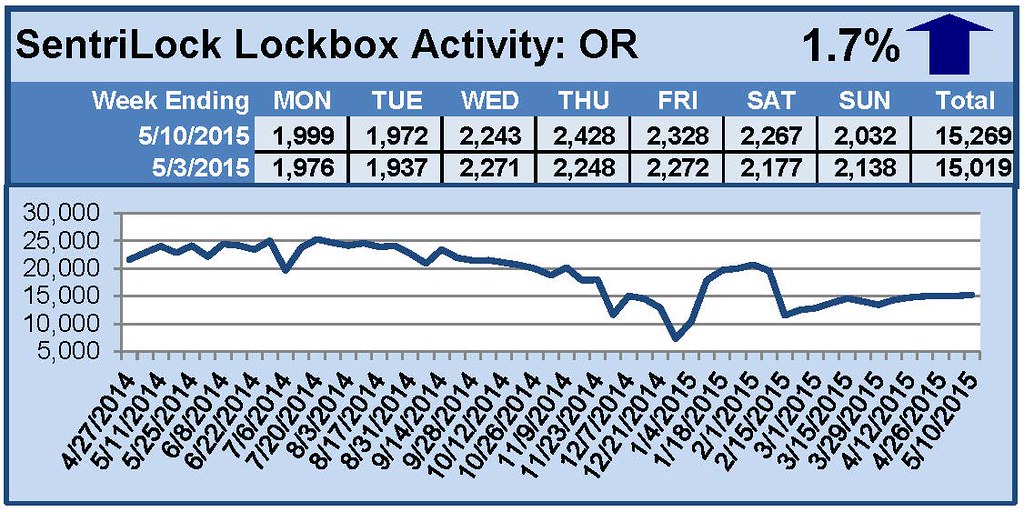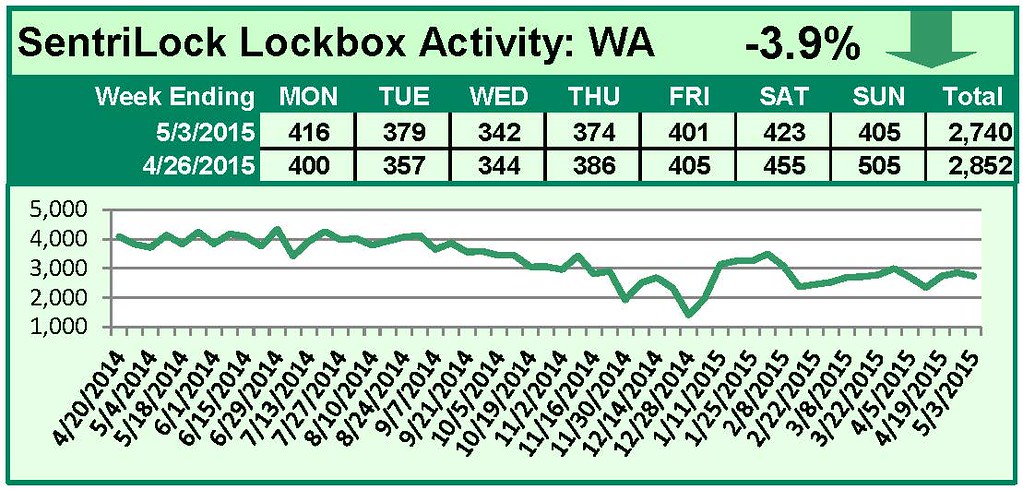
by RMLS Communication Department | May 18, 2015


This Week’s Lockbox Activity
For the week of May 4-10, 2015, these charts show the number of times RMLS™ subscribers opened SentriLock lockboxes in Oregon and Washington. Activity in Oregon and Washington increased this week.
For a larger version of each chart, visit the RMLS™ photostream on Flickr.
![Fair Housing and Advertising]()
by RMLS Communication Department | May 14, 2015
 Following is a guest post by Jo Becker, Education/Outreach Specialist for the Fair Housing Council of Oregon.
Following is a guest post by Jo Becker, Education/Outreach Specialist for the Fair Housing Council of Oregon.
I recently reread a 2009 report produced by the National Fair Housing Alliance (NFHA) on how internet housing ads perpetuate discrimination. As we can attest from our own office’s investigations, illegal ads are prolific online, decades after the Fair Housing Act made them illegal. Following are some highlights from the report.
There is no disagreement that landlords, real estate agents, and others who create and place these discriminatory ads are legally liable for violating the Fair Housing Act. In passing the Fair Housing Act in 1968, Congress wanted to hold publishers responsible for third parties as a way of eliminating the problem most efficiently.
Every day in the United States, thousands of people view rental advertisements that illegally deny housing to families with children and others protected by the federal Fair Housing Act. Although newspapers have been held liable under the Fair Housing Act for publishing discriminatory housing advertisements with statements such as “no kids,” or “couples only,” the publishers of similar ads on the internet have not been held to the same legal standard.
In order to address this disparity in the law, which holds print advertisements and online advertisements to separate and unequal standards, the National Fair Housing Alliance (NFHA) urges Congress to amend the Communications Decency Act.
The Fair Housing Act makes it illegal to make, print, or publish; or cause to be made, printed, or published; housing ads that discriminate, limit, or deny equal access to apartments or homes because of race, color, national origin, sex, religion, familial status, and disability. [There are, of course, additional state and locally protected classes.]
In order to comply with the Fair Housing Act, newspapers utilize screening systems to keep advertisements containing discriminatory statements from being printed. [And they’re often much more conservative than fair housing advocates are! Take a look at FHCO’s popular article, The List, for more on this and related urban legends.] However, a legal interpretation of the Communications Decency Act (CDA) holds that interactive internet providers, like Craigslist, are not publishers and therefore are not liable for violating the Fair Housing Act if discriminatory housing ads are published on their sites.
Yet it needn’t be difficult. Internet providers can implement filtering systems just as print publications can (arguably it’d be easier for them to do so) to prevent individuals from posting illegally discriminatory verbiage. Either way, whether or not a site is liable in a given situation (we feel it is), the poster most certainly is!
As a housing provider advertising residential properties, you should know that fair housing advocates such as our office, national groups, and others, periodically comb sites and publications for violations. Our advice: treat any form of advertising—whatever your role is in it—as if it falls under federal, state, and/or local fair housing laws. This includes written, printed, online, posted signs, oral statements, etc., whether free or paid.
During the past year, NFHA and [several of its members] identified more than 7,500 discriminatory ads placed by housing providers on various websites. Yet, only 1,000 complaints have been filed with the US Department of Housing and Urban Development (HUD) because both HUD and private fair housing agencies lack the staff and time to work through the cumbersome process required to identify and bring these landlords to justice.
Sadly, these ads reinforce the message to public readers that refusing to rent, sell, lend, or insure based on any of the protected classes is acceptable and even legal. What’s more, it confuses those who wish to follow the law or would be inclined to if they were better informed. All the reason for the proactive stance FHCO has always taken on education as a tool to eradicate illegal housing discrimination coupled, of course, with enforcement activities—because the battle won’t be won with a carrot alone.
The Fair Housing Act covers all advertising for the rental or sale of homes as well as advertising for home loans, homeowners/renters insurance, and any service related to housing.
Language in the Fair Housing Act and in the regulations implementing the law makes it clear that the law is also intended to prevent newspapers and other media from publishing advertisements or notices that limit housing to specific individuals or indicate a preference for certain people. The law states:
It shall be unlawful to make, print, or publish or cause to be made, printed, or published any notice, statement, or advertisement with respect to the sale of rental of a dwelling that indicates any preference, limitation, or discrimination based on .
The NFHA report identified thousands of ads that violate the Fair Housing Act—in all 50 states and the District of Columbia, including Portland and Bend, Oregon. As a result, the national organization filed over a thousand complaints with HUD against posters.
The most common Fair Housing Act violation that NFHA and its members found on the internet was advertising discriminating against families with children. NFHA found ads stating preferences for tenants who were “single” or “a couple of individuals.” Phrases such as “perfect for young couple” or “three adults” were found in ads for houses or apartments with multiple bedrooms. These ads indicate an illegal preference or limitation and discourage families with children from even considering contacting a landlord. [Note: this is different than occupancy standards.]
Many of the properties with such discriminatory language have multiple bedrooms, and would be ideal for families with children. Some examples of discriminatory language identified include:
- 2BR: “Mature couple or single with no children” NY
- 3BR: Duplex: “Christian atmosphere” IN
- 2BR: “PERFECT FOR TWO ADULTS…seeking a maximum of two tenants” CT
- 2BR: “Couples preferred” IL
- 4BR: “Looking for responsible adults to enjoy home” VT
Even if these happen to be located in designated senior communities, the description of the community as an “adult community” or the advertising of “no kids allowed” is specifically disallowed by HUD.
A couple of my favorites that touch on other protected classes include:
- “Looking for a white lady who has a car and that’s drawing a check. No children, teenagers” TN
- “We’re trying to make cheaper rent available for able-bodied people who can do a few things for themselves.” GA
and from here in Oregon…
- RV Hookup: “Hopefully we can find someone that is a Christian and loves God with all of their hearts” OR
Be sure you’re well informed and complying with both the letter and the spirit of fair housing laws. Schedule a fair housing class for your staff today, or ask your local association when FHCO will be offering a class through them. In the meantime, visit the newly revised Fair Housing Council of Oregon website and make full use of the information and resources posted there. Sign up for the free FHCO electronic newsletter to keep up to speed with developments in the fair housing world.
Read the full report—For Rent: No Kids! How Internet Housing Advertisements Perpetuate Discrimination.

by RMLS Communication Department | May 11, 2015


This Week’s Lockbox Activity
For the week of April 27-May 3, 2015, these charts show the number of times RMLS™ subscribers opened SentriLock lockboxes in Oregon and Washington. Activity in both states decreased this week.
For a larger version of each chart, visit the RMLS™ photostream on Flickr.
![Fair Housing and Advertising]()
by RMLS Communication Department | May 6, 2015

The National Association of REALTORS® (NAR) recently released a new tool to manage what potential clients learn about you on Realtor.com and major social media sites.
Have you claimed your free Realtor.com profile page yet?
The Realtor.com profile page is a one-stop portal that allows NAR members to connect with clients looking for a REALTOR® while searching for homes on Realtor.com.
The profile allows each REALTOR® to manage the display of information and client recommendations from a variety of social sites, including Facebook, Twitter, and LinkedIn. This means clients can easily find an experienced REALTOR® with a particular specialization or language, or discover a REALTOR® who has served someone they know. One-stop shopping for clients, and easy lead generation for brokers!
What do you need to start? A NRDS number and your browser. Claim your profile today on Realtor.com, then peruse the quick start guide to make the most of your new profile.

![Fair Housing and Advertising]()
by RMLS Communication Department | May 5, 2015
 John Van Loo passed away on April 23, 2015, leaving a substantial hole in our real estate community. RMLS™ joins his family, friends, fellow REALTORS®, and co-workers at RE/MAX Equity group in mourning his loss. John served as a valued Director on the RMLS™ Board of Directors for eleven years. He joined the board in 1994 for his first term which ended in 1996, and then rejoined in 2004, serving through 2011.
John Van Loo passed away on April 23, 2015, leaving a substantial hole in our real estate community. RMLS™ joins his family, friends, fellow REALTORS®, and co-workers at RE/MAX Equity group in mourning his loss. John served as a valued Director on the RMLS™ Board of Directors for eleven years. He joined the board in 1994 for his first term which ended in 1996, and then rejoined in 2004, serving through 2011.
John was the Chairman of the Board in 2008, and gently guided RMLS™ through a difficult year. Our then CEO, Beth Murphy, was out on an extended medical leave through much of the second half of the year and the recession was was making itself felt. Budgets needed to be pared. In all, John served RMLS™ on the Executive Committee for five years from 2005-2009.
Like so many people, I was a personal recipient of his wonderful nature. In the year John was our Board Chairman, I was meeting him for dinner at the end of a long trip to the NAR mid-year meetings in Washington, DC. Arriving at the restaurant to meet him, I foolishly left my wallet in the cab and it sped away. Nothing could have exceeded the kindness and practical help that John and his family provided. My wallet was miraculously returned, but I never forgot that glimpse of John’s true humanity.
Kurt von Wasmuth, our RMLS™ President and CEO, was appointed Acting CEO during John’s chairmanship in 2008. In his words, “John was a dedicated leader that helped guide RMLS™ during a time when we needed him the most. He will be sorely missed.”
A celebration of John Van Loo’s life will be held on Thursday, May 28, 2015, at Abundant Life Church in Happy Valley, OR.







